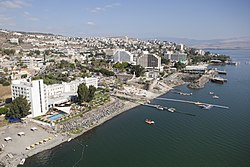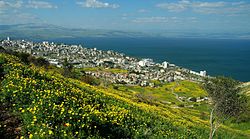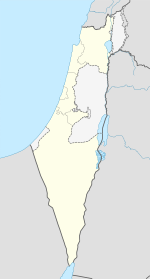提比里亞
外观
提比里亞
| |
|---|---|
| 希伯來語轉寫 | |
| • 轉寫 | Teverya |
 | |
| 坐标:32°47′40″N 35°32′00″E / 32.79444°N 35.53333°E | |
| 行政区划 | 北部区 |
| 政府 | |
| • 类型 | 城市 |
| • 市長 | 罗恩·科比 |
| 面积 | |
| • 总计 | 10,872 杜纳亩s(11 平方公里 或 4 平方英里) |
| 人口(2021年)[1] | |
| • 總計 | 46,698人 |
| 聖經人物或地方名稱 | |
|---|---|
| 天主教譯名 | 提比里亞 |
| 新教譯名 | 提比里亞 |
| 伊斯兰教譯名 | 提比里亞 |
| 希伯來语 | טבריה |
| 希伯來語轉寫 | Təverya |
| 提比里亞希伯來語拼音 | Ṭəḇeryāh |
| 古希臘語 | Τιβεριάς |
| 阿拉伯语 | طبرية |
| 阿拉伯語轉寫 | Ṭabariyyah |


提比里亞或太巴列(希伯来语:טְבֶרְיָה,Tveria,Tiveriaⓘ,阿拉伯语:طبرية,Ṭabariyyah,古希臘語:Τιβεριάς,Tiberiás,希臘語:Τιβεριάδα,Tiveriáda,英語:Tiberias,/taɪˈbɪəriəs/),以色列城市,位於以色列北部加利利海畔的下加利利。是以色列的一個古城。和耶路撒冷、采法特和希布伦并列为犹太教四大圣城之一。
提比里亞,建於公元20年,由大希律王的兒子、加利利行省的分封王希律·安提帕斯於拉甲(Rakkat)的廢墟上所建[2][3],並成為加利利行省的省會。「提比里亞」的名字源自當時羅馬帝國的皇帝提庇留。[4]
希律王執政時,猶大行省的猶太人拒絕前往當地定居,認為當地不潔淨,因為當地有一個墳場。17世紀左右,提比里亞被視為是猶太教四大聖城之一。[5] 猶太傳統相信彌賽亞在當地崛起[來源請求],而猶太公會亦會在當地復興。
姊妹城市
[编辑]提比里亞的友好城市有:
 中國无锡市,自2007年起
中國无锡市,自2007年起 法國蒙彼利埃,自1983年起
法國蒙彼利埃,自1983年起 德国厄姆斯,自1986年起
德国厄姆斯,自1986年起 美国威斯康辛州密爾沃基,自1989年起
美国威斯康辛州密爾沃基,自1989年起 美国奧克拉荷馬州圖爾薩
美国奧克拉荷馬州圖爾薩 美国纽约州大內克
美国纽约州大內克 法國圣拉斐尔 (瓦尔省),自2007年起
法國圣拉斐尔 (瓦尔省),自2007年起
參考文獻
[编辑]- ^ Regional Statistics. Israel Central Bureau of Statistics. [2023-02-22].
- ^ TIBERIAS - JewishEncyclopedia.com. [2008-03-28]. (原始内容存档于2008-10-10).
- ^ 約書亞記19:35 "堅固的城就是:西丁、側耳、哈末、拉甲、基尼烈"
- ^ Josephus. Antiquities of the Jews. XVIII.2.3. [2021-12-20]. (原始内容存档于2022-04-08).
- ^ Wigoder, Geoffrey (编). The Encyclopedia of Judaism. Macmillan: 768. 1989.
Term applied to the Erets Israel cities of Jerusalem, Hebron, Safed and Tiberias. These were the four main centers of Jewish life after the Ottoman conquest of 1516. The concept of the holy cities dates only from the 1640s, when the Jewish communities of Jerusalem, Hebron, and Safed organized an association to improve the system of fundraising in the Diaspora. Previously, such fundraising had been undertaken by individual institutions; now it was agreed that the emissaries would be sent on behalf of each urban Jewish community as a whole, with not more than one emissary per town. After Tiberias was refounded in 1740, it also joined the association. This arrangement did not last long, however, and by the mid-19th century there was no authority strong enough to enforce a centralized collection of ḥalukkah funds. The term "Four Holy Cities" became a convenient designation by historians rather than the title of an actual functioning body. In Jewish tradition, going back to ancient times, the only city regarded as holy is Jerusalem


